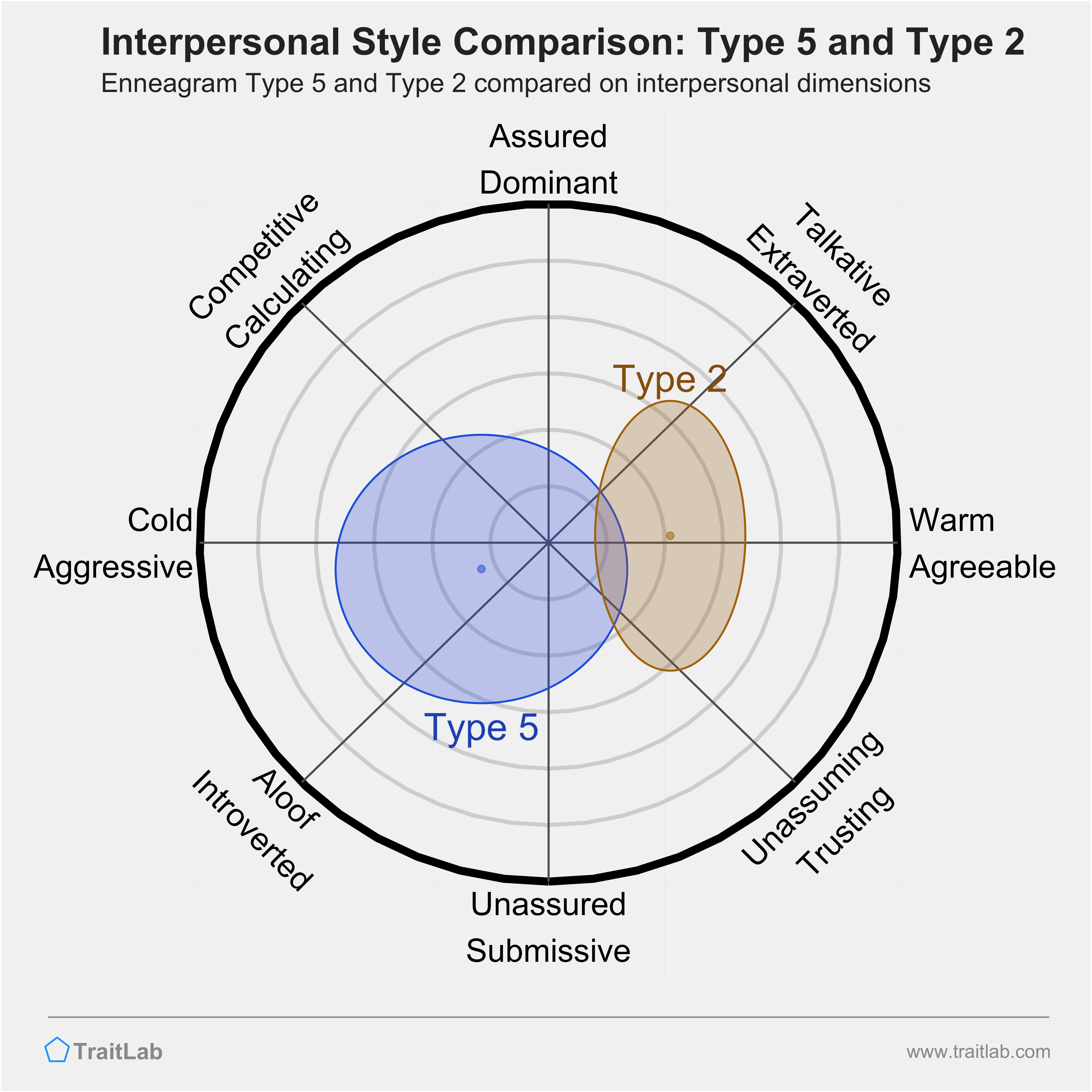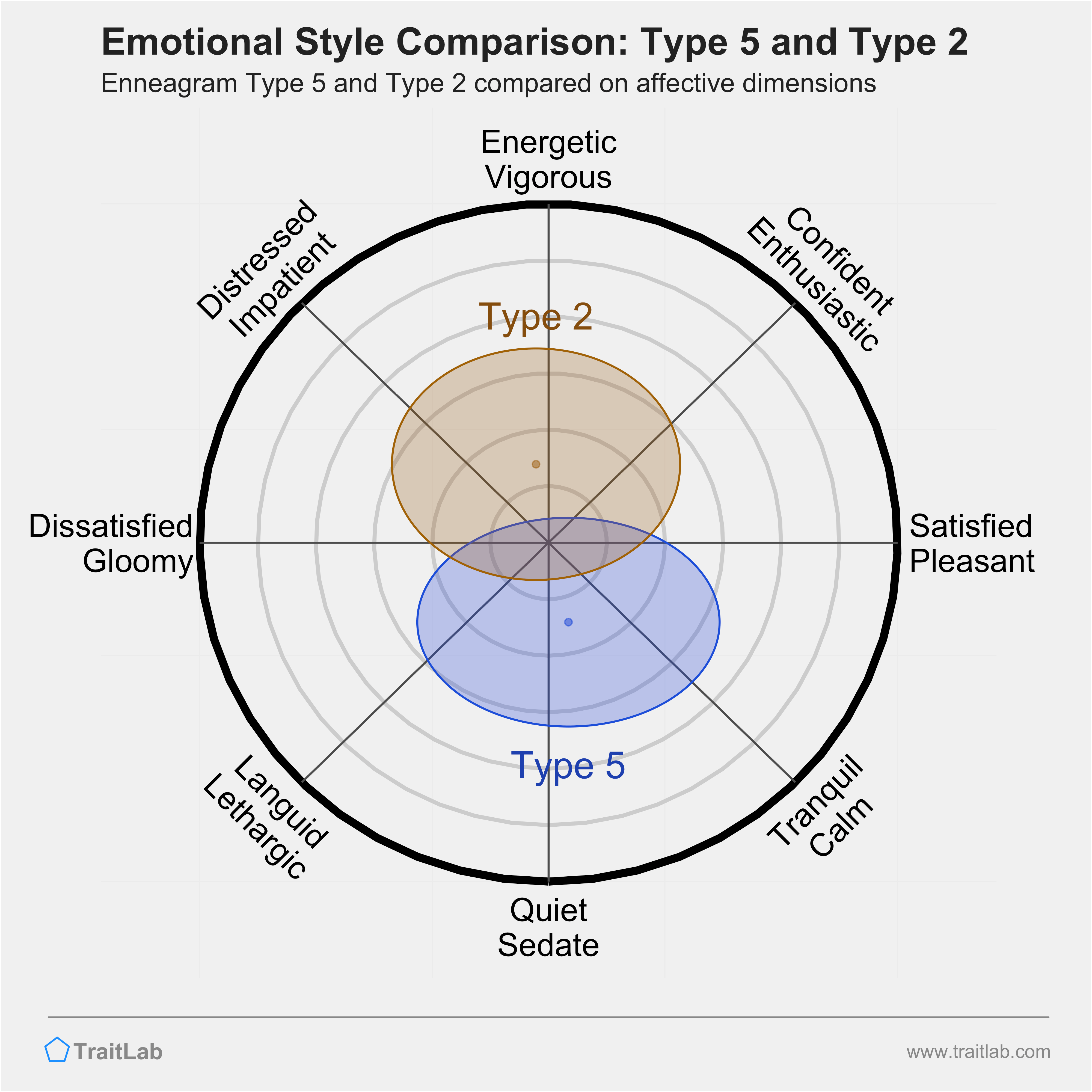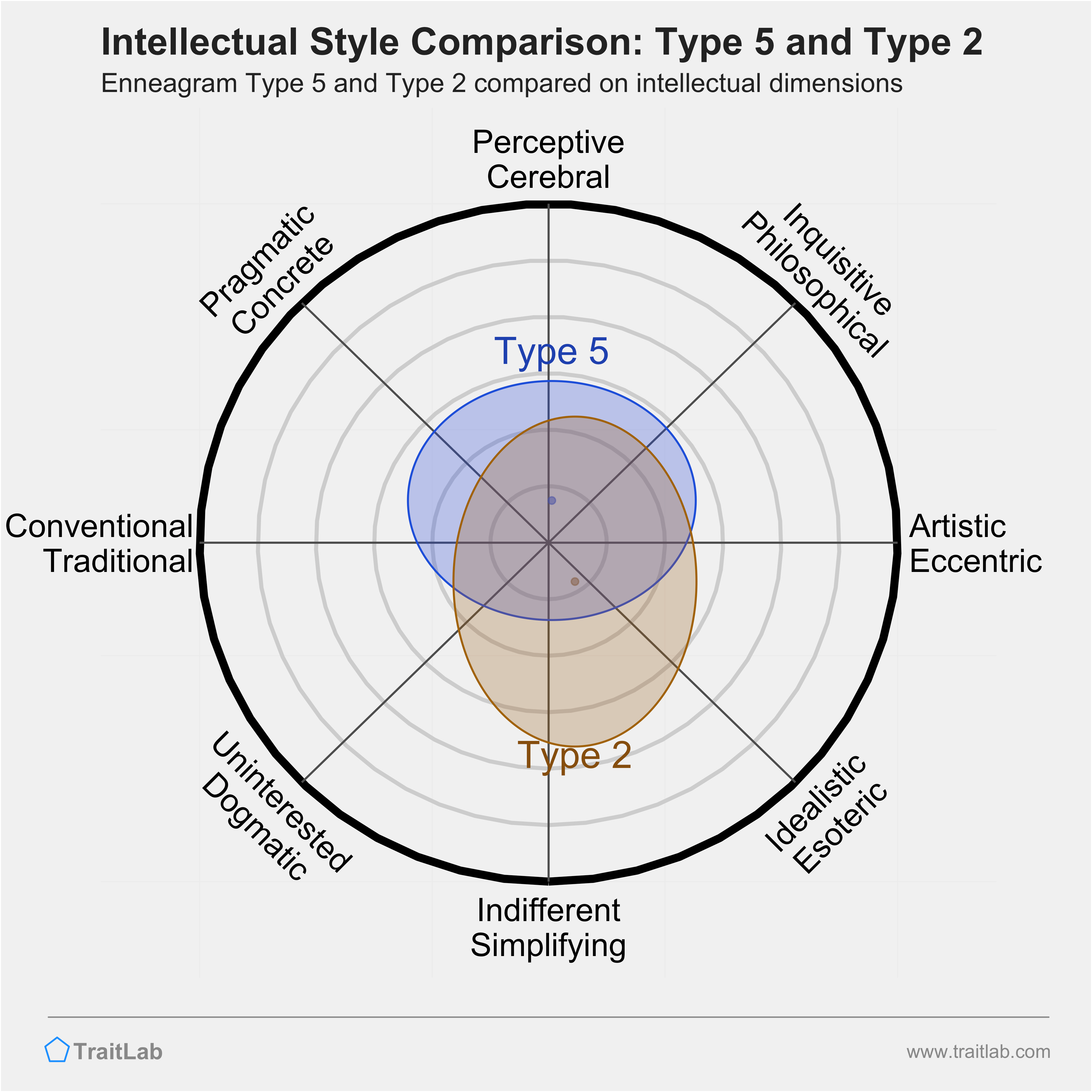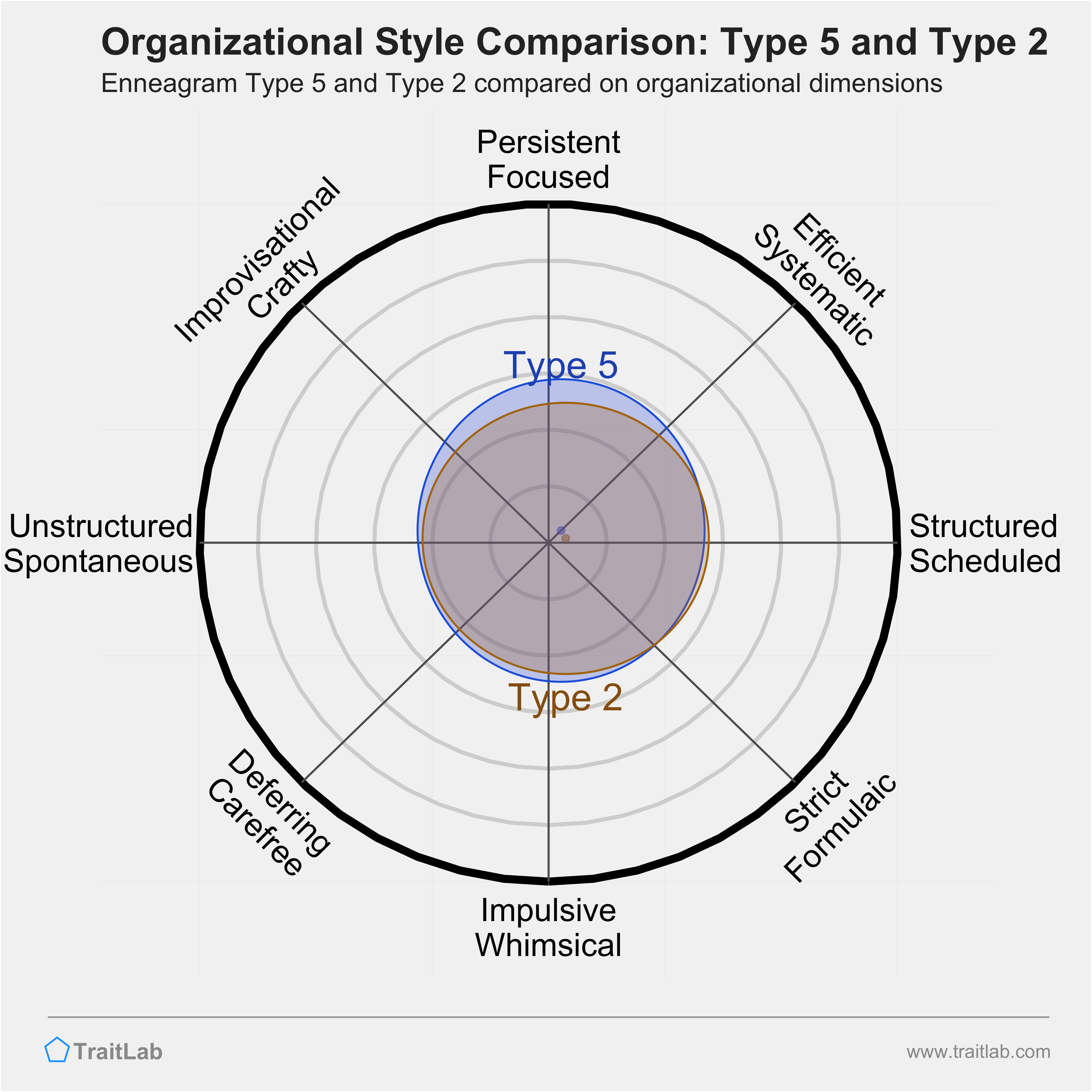How compatible are the Enneagram Type 5 and Type 2 patterns of communicating, feeling, and thinking?
Reading time: 5 minutes

Gregory Park, Ph.D.
Author
In this article, you’ll find comparisons of two Enneagram types — Type 5s and Type 2s — across four important personality domains: Interpersonal/Communication Style, Emotional Style, Intellectual Style, and Organizational Style.
TraitLab collected data about personality traits from thousands of participants who identified as a single Enneagram type.
For each comparison area below, you’ll see show the average similarities and differences between Type 5s and Type 2s. While these comparisons are useful for understanding broad trends across these types, it’s important to remember that all personality types are oversimplifications. For an assessment of your unique personality, you’ll want to use an assessment that goes beyond single personality types.
To learn more about how this typology relates to personality traits, you’ll want to read Enneagram and Big Five Personality Traits.
Jump to any section with the links below.

Do you know your Enneagram type?
Learn about your type and so much more with TraitLab's comprehensive personality assessment.
Your particular style of communicating and interacting with others can be described fairly well by two dimensions: assertiveness and warmth.
Assertiveness describes your tendency to assert yourself, lead, and influence others in social situations, while warmth describes your tendencies to empathize and put others’ needs ahead of your own.
People with the same personality type often share some similarities in assertiveness and warmth. In the graph below, you can see where most Type 5s and most Type 2s fall along both of these dimensions.
First, take a look at where people in each type, on average, fall in this interpersonal space.

Type 5s are forthright, firm, and speak their mind directly. At their best, they are fiercely independent and unaffected by the thoughts and opinions of others. Type 5s may be harsh, frank, or insensitive in their criticism of others. At their worst, they can be overly aggressive and too eager to fight and argue with others.
Type 2s often agree, trust, and cooperate with others. At their best, they are friendly, affectionate, and bring out the warmth and sympathy in others. Type 2s may be too agreeable and quick to compromise. At their worst, they may seek approval and agreement too much, and be dependent on the approval of other people.
As a Type 5, one notable difference between you and most Type 2s is in your interpersonal warmth. You are likely on the colder, more combative side of the spectrum. Compared to you and other Type 5s, Type 2s can sometimes feel overly focused on feelings and intentions, rather than the facts of the matter at hand.
Another important difference between you and most Type 2s is in your relative assertiveness or passivity in social situations. Like many Type 5s, you are often on the more passive, reserved side of the spectrum. In some cases, this is a perfect compliment to Type 2s’ more dominant, assertive style, and the two of you can make an effective team. However, you may find that you need to put extra effort into making your opinions heard when working with Type 2s.
Another characteristic of your personality is your emotional style — your tendencies towards different kinds of moods. There are two dimensions that influence emotional style: arousal and valence.
Arousal describes your relative energy level across different situations. Those with high baseline levels of arousal tend to be generally more alert, active, and engaged, while those with a lower baseline are more reserved, subdued, and inhibited.
Valence describes whether these moods tend to be positive (pleasant) or negative (unpleasant). People with a more positively valenced style are more likely to experience emotions like joy, enthusiasm, satisfaction, and serenity. People with a more negatively valenced style are more likely to experience sadness, frustration, dissatisfaction, and anxiety.
The graph below shows where each type, on average, usually sits in this emotional space.

Type 5s tend to be reserved, laid-back, and content. They often see the glass as half-full, confident that things will eventually work out for the best. Type 5s typically respond to challenges with quiet optimism and rarely become overwhelmed when things get difficult. When their efforts fail, they calmly dust themselves off and try again.
Type 2s tend to be tense, concerned, and vigilant in many situations. They usually have a pessimistic outlook and are often looking for what could go wrong next. Type 2s are highly active and tend to juggle many tasks. When things go wrong, this energy can turn into frustration and impatience, and they are more likely to express their dissatisfaction to others.
As with most Type 5s, you tend to be more reserved, inhibited, and quiet than most Type 2s. Between the two of you, you are more likely to need more personal space, solitude, and time to decompress. While you can tolerate long periods of calm and quiet, your Type 2 counterparts often craves more engagement and excitement. In the best cases, a Type 2 can pull you out of your comfort zone and get you out into the world, while your quiet nature helps to balance out their intensity.
Another difference between Type 5s and Type 2 is in their typical emotional valence, which describes tendencies towards positive or negative emotions. You and most Type 5s tend to fall on the more positive side. Compared to most Type 2s, you and most Type 5s experience positive emotions such as joy, satisfaction, and happiness more often than most Type 2s. Type 2s have the opposite pattern, and they tend to gravitate towards more negative emotions.
These subtle emotional differences often surface in your reactions to new information. The same news that sparks enthusiasm in you and most Type 5s can induce worry in Type 2s. Compared to Type 5s, most Type 2s may need additional time and space to recover from stress.
Your intellectual style describes how you receive, process, and pursue different kinds of information. Differences in intellectual style are captured well by two dimensions: ideas and aesthetics.
Ideas describes your appetite for new information and your interest in complex, challenging material. People high on the ideas dimension have an appreciation for complexity and technical details. People lower on ideas are less interested in learning for learning’s sake, and they prefer to simplify complex topics down to the essential details.
Aesthetics captures your relative interest and sensitivity to aesthetic information and its emotional impact. People higher on the aesthetics dimension usually have strong artistic interests and a deep appreciation for beauty in many forms. Those lower on aesthetics tend to value practical application over artistic merit and usually adhere to more conventional standards of beauty.
In the graph below, you’ll see where Type 5s and Type 2s, on average, fall in this intellectual space.

Type 5s tend to be deep thinkers — bright, curious, and philosophical. They are highly receptive to new ideas and drawn to complex, abstract concepts. Type 5s enjoy taking in large amounts of information and typically have one or more creative outlets.
Type 2s are idealistic, creative dreamers. They tend to be interested in the nuances of emotional and artistic experiences, looking for patterns and meaningful insights. Type 2s are comfortable with ambiguity and abstract concepts, focusing on the big picture rather than technical details. They often practice some form of creative expression and are likely to hold a few unconventional, eccentric beliefs.
As with many Type 5s, you tend to have a stronger need for information and complexity than most Type 2s. You are much more likely to become enamored with a fascinating new idea and dive head first into learning everything you can about it while your Type 2 counterparts are focused on the practical matter in front of them. You may find yourself pulling the conversation to a more theoretical level when you’re together, while your Type 2 partner resists and keeps things down-to-earth.
Likewise, both Type 5s and Type 2s share a deep appreciation for beauty in the natural and artistic world. Both of you can easily become absorbed in aesthetic experiences and overcome with a sense of awe and wonder. The two of you can find common ground in your love of creative expression and unconventional approaches to life’s challenges.
Your organizational style describes your habits around organization and planning. Your organizational style influences how you structure your time and physical space. Differences in organizational style fall along two dimensions: industriousness and orderliness.
Industriousness describes your persistence, need for achievement, and intensity of focus. People higher on industriousness usually organize their behavior around a few important long-term goals. People lower on industriousness are usually more focused on the present and will more easily change their focus when new opportunities appear.
Orderliness describes your need for regularity, order, and structure in your environment. People higher on orderliness prefer tidy, organized physical spaces, detailed schedules, and reliable routines. People lower on orderliness can tolerate more disorganization and prefer a more spontaneous, unstructured approach.
The graph below shows the average position of Type 5s and Type 2s along these dimensions of organizational style.

Most Type 5s and Type 2s share a similar organizational style.
Type 5s and Type 2s are usually systematic and highly organized. They like setting big, long-term goals and then creating detailed plans to accomplish them. Type 5s and Type 2s are generally good at ignoring distractions and making steady progress through consistent routines and habits.
As a Type 5, you and most Type 2s share a natural drive to achieve and perform at a high level. Both of you enjoy setting goals and pushing yourselves to accomplish them, and you likely share an interest in self-improvement and productivity strategies. As a result, you and your Type 2 counterpart can fuel each other’s ambition and keep each other accountable as you work towards your long-term goals. However, between the two of you, nobody usually reminds you to slow down and enjoy the present.
Similarly, Type 5s and Type 2s tend to be neat, tidy, and organized. You both rely on high amounts of structure and routine and compared to most people, you have lower tolerances for messiness and disorder. With a few exceptions, both of you stick closely to most social conventions and feel uncomfortable straying from them.
Most people have complex personalities and can’t be described perfectly by a single Enneagram type.
With TraitLab’s comprehensive analyses of your traits, strengths, and interests, you can see how your personality compares to all nine Enneagram types. Start building your personality profile by creating a free account today.
For comparisons between Type 5s and other Enneagram types, visit any of the type pairings below:
For comparisons between Type 5s and other types from the 16 Personality typology, visit any of the pairings below: